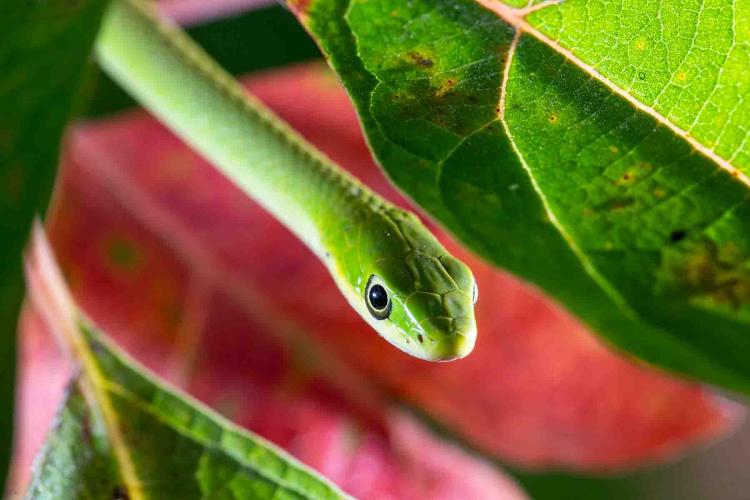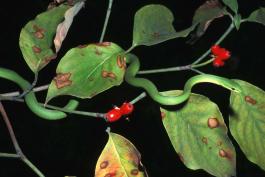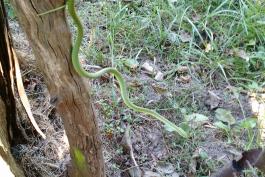
The northern rough greensnake is a slender, light green snake that lives among the branches of trees and shrubs. The upperside color is plain light green; the belly is yellow or cream colored and has no markings. The scales along the back and sides are weakly keeled (ridged), making it feel rough to the touch. This snake's elongated body and long, slender tail allow its weight to be evenly spread across the branches and leaves of trees and bushes.
Some hours after death, rough greensnakes lose the yellow pigmentation within their skin and turn blue.
To people, rough greensnakes are a gentle and harmless species. When first captured, a greensnake may gape open its mouth and reveal a purplish-black lining, but this is a bluff, and most specimens will not try to bite. When newly captured, greensnakes may, as a form of defense, produce a musk from glands at the base of the tail that may be mixed with feces.
Similar species: The smooth greensnake (O. vernalis) used to live in the northern parts of our state, but it has not been seen in Missouri since 1970. A Missouri species of conservation concern, it is considered extirpated from our state. The easiest way to tell the two greensnakes apart is by touch: The scales on the back of a rough greensnake feel rough; those on the back of a smooth greensnake feel smooth. The smooth greensnake also lives in different regions and habitats: it is a grassland (not a woodland) species, and in Missouri, it would be expected to occur only in the northern half of the state, most likely as relict populations in our extreme northern counties (not in the Ozarks).
Adult length: 22 to 32 inches; occasionally to 46 inches. The tail may account for up to nearly half of the total length. Adult females are larger than adult males; males have a longer tail than females.

In Missouri, occurs throughout the southern two-thirds of the state and along the Mississippi River Hills in northeastern Missouri.
Habitat and Conservation
This arboreal (tree-living) species resides in the dense trees and shrubs that grow along creeks, rivers, ponds, reservoirs, and forest edges. They spend most of their time resting among branches between about 3 to 13 feet above the ground.
This species has not been well studied in Missouri. Studies in Arkansas showed that rough greensnakes were almost always found within about 10 feet of a pond, creek, or other body of water. But observations in North Carolina found a majority of individuals living on the ground. In Missouri, rough greensnakes appear to live in a variety of brushy, viny, wooded riparian habitats as well as rocky, forested hillsides, river bluffs, and even sometimes under flat rocks.
The active season of this species is late March through October, with peak activity in spring (April and May) and autumn (September and October).
The rough greensnake is active by day and spends most of its time among the branches and leaves of trees and bushes. It remains motionless among leaves and branches. Its leaf-green coloration functions as camouflage. If a slight wind moves the branches, the greensnake will bend and wave along with the foliage.
This species becomes active soon after sunrise. They select their nighttime resting sites about an hour before sunset. At night, these snakes coil among leaves near branch tips.
Rough greensnakes may be observed crossing roads, trails, and creeks during the active season. People often see them crossing the former railroad bed of Katy Trail State Park; most of these snakes are migrating from the Missouri River floodplain into the nearby rocky, wooded hillsides.
Rough greensnakes are capable swimmers; people sometimes see them swimming across Ozark streams.
They overwinter in deep leaf litter, inside rotten logs and stumps, and in the ground at a depth of more than 8 inches.
Food
Rough greensnakes eat mostly insects and spiders. More specifically, their prey includes spiders, hairless caterpillars, grasshoppers, crickets, beetles, dragonflies, and damselflies . Rough greensnakes also may eat young treefrogs, land snails, praying mantids, wood roaches, katydids, and walking sticks.
Slender, arboreal, and insectivorous snakes like this species must eat more prey, and eat more often, to sustain themselves and reproduce, compared to snakes that eat vertebrate prey.
Status
Missouri populations are considered secure.
Life Cycle
Mating occurs in the spring and sometimes during autumn. Egg laying occurs in June and July, about 35 days after mating. Pregnant females leave the safety of trees to find nesting spots in deep leaf litter, under brush piles, behind the loose bark of a standing dead tree, or in or rotten logs or stumps. The female produces 1–14 eggs, with an average of 6. There is only 1 clutch per year. Incubation usually lasts up to about 2 months (22–91 days), with most clutches hatching in August and September.
Male rough greensnakes are reproductively mature at the age of 1 year, and females are mature at age 2 or 3. They may survive to age 8 in the wild.
Human Connections
One of Missouri's most attractive snakes, it is also harmless to people.
Animals that eat insects can be harmed indirectly by pesticides. This is apparently one of the reasons why the similar-looking smooth greensnake of northern Missouri disappeared from our state. So far, the rough greensnake seems to have been spared that fate, but it is especially vulnerable to insecticide contamination.
Rough greensnakes are often found dead on Missouri’s roads and highways.
The genus name, Opheodrys, is from Greek roots and means "tree snake." The species name, aestivus, is from the Latin word for "summer."
Ecosystem Connections
These slender snakes eat mainly insects and spiders, and they help to check the populations of many caterpillars that feed on the leaves of trees.
Predators of this species include hawks, blue jays, kingsnakes, domestic cats, and more.
Rough greensnakes have a special adaptation that protects them from the sun’s ultraviolet radiation. Because they are active by day and live in trees, they spend much of their time in direct sun. Their internal organs — especially their reproductive organs — must be protected from the sun’s damaging ultraviolet radiation. This species has a black peritoneum. The peritoneum is an envelope covering the internal organs, and having it pigmented with black provides a shield preventing damage from ultraviolet radiation. Globally, several other tree-living snakes have this adaptation, but this trait is unlikely to be found in many other Missouri snakes. A study of worldwide genetic relationships of snakes in the family Colubridae found that the North American rough greensnake originated from arboreal snakes found in tropical East Asia.
The camouflage coloration of a greensnake is enhanced by its instinctive behavior of waving its body gently in the breeze. Other, unrelated animals perform similar camouflage movements. One example is the American bittern, a stealthy brown-streaked heron that lives among tall marsh grasses. When alarmed, it extends its neck and dagger-shaped bill straight upward and stands motionless. It enhances its camouflage by swaying slightly with the nearby grasses in the breeze. Northern walkingsticks (insects that look like twigs and live in trees) perform similar breeze-swaying motions.






























